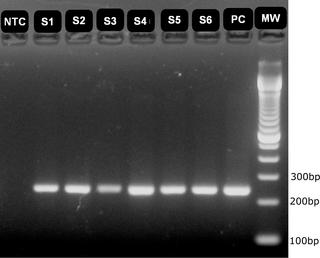当前位置:
X-MOL 学术
›
PLOS Negl. Trop. Dis.
›
论文详情
Our official English website, www.x-mol.net, welcomes your
feedback! (Note: you will need to create a separate account there.)
Development of RT-qPCR and semi-nested RT-PCR assays for molecular diagnosis of hantavirus pulmonary syndrome.
PLOS Neglected Tropical Diseases ( IF 3.4 ) Pub Date : 2019-12-26 , DOI: 10.1371/journal.pntd.0007884 Bruno Tardelli Diniz Nunes 1, 2 , Maria Helena Rodrigues de Mendonça 1 , Darlene de Brito Simith 1, 2 , Adriana Freitas Moraes 1 , Carla Conceição Cardoso 1 , Ivy Tsuya Essashika Prazeres 1 , Ana Alice de Aquino 1 , Alessandra da Conceição Miranda Santos 1 , Alice Louize Nunes Queiroz 1 , Daniela Sueli Guerreiro Rodrigues 1 , Regis Bruni Andriolo 3 , Elizabeth Salbé Travassos da Rosa 1 , Livia Carício Martins 1 , Pedro Fernando da Costa Vasconcelos 1, 2 , Daniele Barbosa de Almeida Medeiros 1, 2
PLOS Neglected Tropical Diseases ( IF 3.4 ) Pub Date : 2019-12-26 , DOI: 10.1371/journal.pntd.0007884 Bruno Tardelli Diniz Nunes 1, 2 , Maria Helena Rodrigues de Mendonça 1 , Darlene de Brito Simith 1, 2 , Adriana Freitas Moraes 1 , Carla Conceição Cardoso 1 , Ivy Tsuya Essashika Prazeres 1 , Ana Alice de Aquino 1 , Alessandra da Conceição Miranda Santos 1 , Alice Louize Nunes Queiroz 1 , Daniela Sueli Guerreiro Rodrigues 1 , Regis Bruni Andriolo 3 , Elizabeth Salbé Travassos da Rosa 1 , Livia Carício Martins 1 , Pedro Fernando da Costa Vasconcelos 1, 2 , Daniele Barbosa de Almeida Medeiros 1, 2
Affiliation

|
Hantavirus Pulmonary Syndrome is an, often fatal, emerging zoonotic disease in the Americas caused by hantaviruses (family: Hantaviridae). In Brazil, hantavirus routine diagnosis is based on serology (IgM-ELISA) while RT-PCR is often used to confirm acute infection. A Semi-nested RT-PCR and an internally controlled RT-qPCR assays were developed for detection and quantification of four hantaviruses strains circulating in the Brazilian Amazon: Anajatuba (ANAJV) and Castelo dos Sonhos (CASV) strains of Andes virus (ANDV) species; and Rio Mamoré (RIOMV) and Laguna Negra (LNV) strains of LNV species. A consensus region in the N gene of these hantaviruses was used to design the primer sets and a hydrolysis probe. In vitro transcribed RNA was diluted in standards with known concentration. MS2 bacteriophage RNA was detected together with hantavirus RNA as an exogenous control in a duplex reaction. RT-qPCR efficiency was around 100% and the limit of detection was 0.9 copies/μL of RNA for RT-qPCR and 10 copies/μL of RNA for Semi-nested RT-PCR. There was no amplification of either negative samples or samples positive to other pathogens. To assess the protocol for clinical sensitivity, specificity and general accuracy values, both assays were used to test two groups of samples: one comprising patients with disease (n = 50) and other containing samples from healthy individuals (n = 50), according to IgM-ELISA results. A third group of samples (n = 27) infected with other pathogens were tested for specificity analysis. RT-qPCR was more sensitive than semi-nested RT-PCR, being able to detect three samples undetected by conventional RT-PCR. RT-qPCR clinical sensitivity, specificity and general accuracy values were 92.5%, 100% and 97.63%, respectively. Thus, the assays developed in this study were able to detect the four Brazilian Amazon hantaviruses with good specificity and sensitivity, and may become powerful tools in diagnostic, surveillance and research applications of these and possibly other hantaviruses.
中文翻译:

RT-qPCR和半巢式RT-PCR分析方法的开发,用于汉坦病毒性肺综合征的分子诊断。
汉坦病毒肺综合症是由汉坦病毒(家庭:汉坦病毒科)引起的在美洲经常引起致命的人畜共患疾病。在巴西,汉坦病毒的常规诊断基于血清学(IgM-ELISA),而RT-PCR通常用于确认急性感染。开发了一种半嵌套式RT-PCR和内部控制的RT-qPCR分析方法,用于检测和定量在巴西亚马逊流传的四种汉坦病毒株:安第斯病毒(ANDV)种的Anajatuba(ANAJV)和Castelo dos Sonhos(CASV)菌株; 以及LNV物种的RioMamoré(RIOMV)和Laguna Negra(LNV)菌株。这些汉坦病毒的N基因的共有区域用于设计引物组和水解探针。在已知浓度的标准液中稀释体外转录的RNA。在双工反应中,检测到MS2噬菌体RNA与汉坦病毒RNA一起作为外源对照。RT-qPCR的效率约为100%,RT-qPCR的检测限为0.9拷贝/μLRNA,半巢式RT-PCR的检测限为10拷贝/μLRNA。阴性样品或对其他病原体呈阳性的样品均未扩增。为了评估协议的临床敏感性,特异性和一般准确性值,两种检测方法均用于测试两组样品:根据一项分析,一组包含疾病患者(n = 50),另一组包含健康个体的样品(n = 50)。 IgM-ELISA结果。对第三组被其他病原体感染的样本(n = 27)进行了特异性分析。RT-qPCR比半嵌套式RT-PCR更为灵敏,能够检测到传统RT-PCR未检测到的三个样品。RT-qPCR的临床敏感性,特异性和一般准确性值分别为92.5%,100%和97.63%。因此,本研究开发的测定方法能够以良好的特异性和敏感性检测四种巴西亚马逊汉坦病毒,并且可能成为这些以及其他汉坦病毒在诊断,监测和研究应用中的有力工具。
更新日期:2019-12-27
中文翻译:

RT-qPCR和半巢式RT-PCR分析方法的开发,用于汉坦病毒性肺综合征的分子诊断。
汉坦病毒肺综合症是由汉坦病毒(家庭:汉坦病毒科)引起的在美洲经常引起致命的人畜共患疾病。在巴西,汉坦病毒的常规诊断基于血清学(IgM-ELISA),而RT-PCR通常用于确认急性感染。开发了一种半嵌套式RT-PCR和内部控制的RT-qPCR分析方法,用于检测和定量在巴西亚马逊流传的四种汉坦病毒株:安第斯病毒(ANDV)种的Anajatuba(ANAJV)和Castelo dos Sonhos(CASV)菌株; 以及LNV物种的RioMamoré(RIOMV)和Laguna Negra(LNV)菌株。这些汉坦病毒的N基因的共有区域用于设计引物组和水解探针。在已知浓度的标准液中稀释体外转录的RNA。在双工反应中,检测到MS2噬菌体RNA与汉坦病毒RNA一起作为外源对照。RT-qPCR的效率约为100%,RT-qPCR的检测限为0.9拷贝/μLRNA,半巢式RT-PCR的检测限为10拷贝/μLRNA。阴性样品或对其他病原体呈阳性的样品均未扩增。为了评估协议的临床敏感性,特异性和一般准确性值,两种检测方法均用于测试两组样品:根据一项分析,一组包含疾病患者(n = 50),另一组包含健康个体的样品(n = 50)。 IgM-ELISA结果。对第三组被其他病原体感染的样本(n = 27)进行了特异性分析。RT-qPCR比半嵌套式RT-PCR更为灵敏,能够检测到传统RT-PCR未检测到的三个样品。RT-qPCR的临床敏感性,特异性和一般准确性值分别为92.5%,100%和97.63%。因此,本研究开发的测定方法能够以良好的特异性和敏感性检测四种巴西亚马逊汉坦病毒,并且可能成为这些以及其他汉坦病毒在诊断,监测和研究应用中的有力工具。











































 京公网安备 11010802027423号
京公网安备 11010802027423号